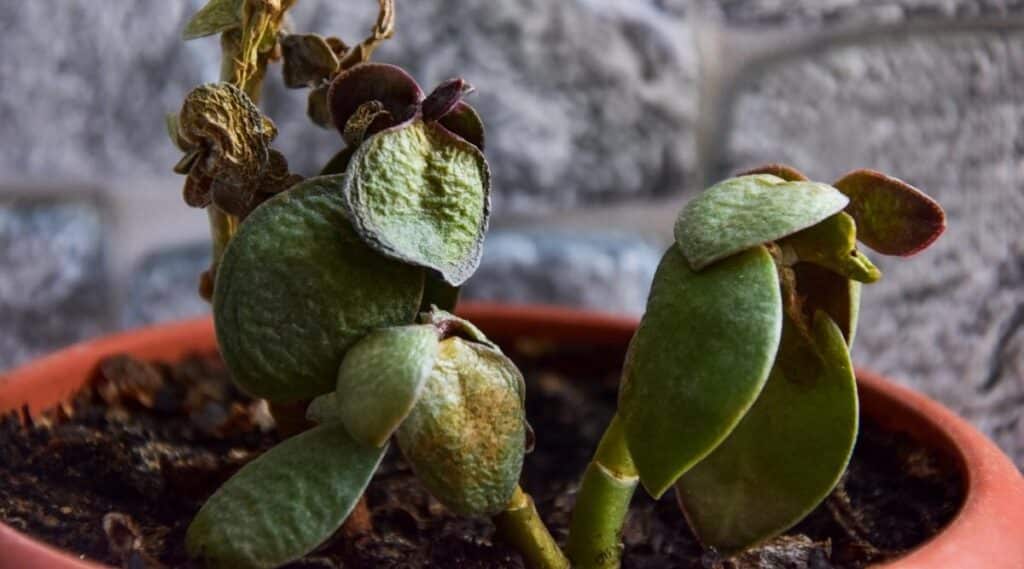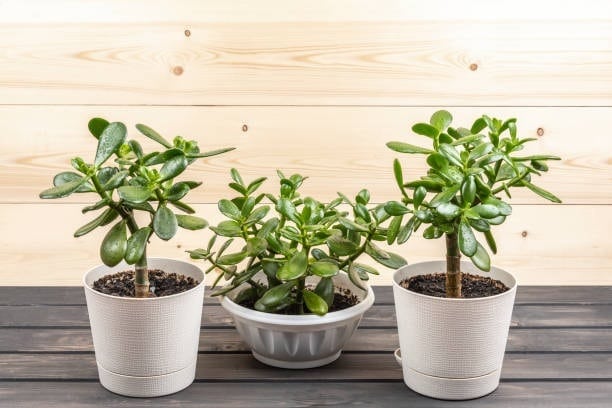As a Feng Shui expert, I’m delighted to share the meaning and benefits of jade plant with the readers of LotusBuddhas. The jade plant (Crassula ovata) is a succulent plant that originates from South Africa, known for its thick, shiny, round leaves that store water, allowing the plant to thrive in arid conditions.
This plant is a popular choice for indoor plants, as it’s easy to care for and can grow in a variety of conditions. With its woody stems and tree-like appearance, the jade plant can grow up to 3 feet tall indoors, creating a captivating focal point in any living space.
But the jade plant is more than just a beautiful plant. In our Feng Shui community, the jade plant is often referred to as the “money tree” or the “lucky plant” because it’s believed to attract wealth, prosperity, and luck. In this article, let’s explore the general knowledge about the jade plant, how to care for it, and discover its mysterious abilities in Feng Shui!
Meaning of Jade Plant in Feng Shui

The jade plant is a true gem in the world of Feng Shui. Often referred to as the “Money Plant“, this friendly green companion brings luck to those who know how to tap into its energy. In many Feng Shui projects, I have seen this small but mighty plant work wonders in many homes and offices, and today I will reveal its secrets to you.
As you may know, the ancient art of Feng Shui is about arranging the environment around us in a way that promotes harmony and balance. And when it comes to attracting wealth and prosperity, there is no better companion than our beloved jade plant. Like the gemstone that it’s named after, jade plant symbolizes prosperity, success, and luck.
In addition, with its thick and succulent leaves, jade plant represents the accumulation of wealth, as the Water element in Feng Shui is closely associated with wealth and prosperity.
Furthermore, this beautiful plant is believed to have the ability to counteract negative energy, protecting your wealth and happiness if placed in the right position. Don’t worry! I’ll guide you in the next section.
How to use Jade Plant in Feng Shui for good luck and wealth

So, you’re excited to learn more about the mystical power of the jade plant in Feng Shui? I wrote this article to answer your questions about jade plant.
Once again, I have to tell you that strategic placement is the determining factor in creating good Feng Shui for any “Feng Shui tool.” And jade plant is no exception.
Firstly, to attract luck and wealth with the jade plant, we need to find a perfect spot for it. You see, in Feng Shui, it’s all about harnessing the appropriate energy flow. And, my dear friend, that magical spot is none other than the Southeast corner of your house or workspace.
That’s right, it’s the “Wealth and Abundance” area, where the energy of the jade plant can unleash its attractive power. To determine the “wealth area,” you’ll need a Bagua map, and each house with different designs, so I can’t guide you in detail.
But wait, there’s more to this story. To truly enhance the luck factor, you need to pair your jade plant with other complementary elements to boost its energy.
For example, placing a fish tank or a mirror near the plant will enhance its ability to attract prosperity and double it up. Trust me, when it comes to Feng Shui, the combination of elements is crucial!
You see, the jade plant is not your ordinary green friend. Its round, succulent leaves are said to resemble coins, symbolizing wealth and abundance. So, if you want to attract more luck, remember to keep those leaves plump and shiny.
In some Vietnamese families that I had the chance to advise, they also believe that tying a red ribbon around jade plant’s pot can help increase its wealth-attracting power.
We’ve talked too much about how to use the jade plant to create good Feng Shui indoors. But don’t forget that jade plant is a living entity, breathing. Treat it with love, and it will reciprocate with favor. Provide it with proper sunlight and water, and you’ll see your luck and wealth grow like never before.
How to care for Jade Plant when growing indoors
As I mentioned earlier, Jade plant is a living entity and you need to know how to care for it properly when growing it indoors.
Firstly, Jade plant or Crassula ovata, as we call it in the botanical world, thrives on well-draining soil. When planting your Jade, opt for a cactus or succulent mix, or create your own mixture using equal parts potting soil, perlite, and coarse sand. And here’s a little tip from my personal playbook: always choose a pot with drainage holes to prevent waterlogged roots.
Next up is light. Jade plants like to be in sunlight, so place them in a spot with plenty of indirect sunlight. A south or west-facing windowsill is a prime location. But be careful, my friend, as direct, scorching sun can burn those lovely, plump leaves. Keep an eye on it and if you notice any leaf scorching, move it to a shadier spot.
Jade plants have a unique feature of storing water in their leaves to combat drought conditions. Therefore, you don’t need to water it too much. Let the soil dry out completely between waterings and then water thoroughly. But here’s a secret: in cooler months, cut back on watering as Jade plants go into a dormant period and need less H2O.
Temperature is another important factor in the happiness of a Jade plant. They prefer temperatures from 65°F to 75°F (18°C to 24°C) during the day and slightly cooler at night. But watch out for drafts and sudden temperature changes! Jade plants are very sensitive to cold, so keep them warm during winter months.
Lastly, I want to share with you about fertilizing. Although Jade plants are not picky eaters, they still appreciate a little snack every now and then. During the growing season (spring and summer), feed your Jade with a balanced, water-soluble fertilizer, diluted to half strength. But remember, during dormancy, it’s best to let your plant rest and hold off on the feeding.
These are great tips on caring for the Jade plant that I have gathered from my friend who is also a botanist. Despite my profession in Feng Shui, I am also passionate about plants. Remember that jade plants, and money plants in general, only have positive effects when they are well-cared for and thriving.
Common problems of Jade Plant

Although the Jade plant is quite easy to grow and flourishes in various conditions, this hardy succulent can still face its own challenges. Fear not, my friend, for today I will reveal some common issues that may arise with your jade plant and how to address them like a pro.
First up is root rot: This is perhaps the most common issue that Jade Plant enthusiasts encounter. You see, these succulents store water in their leaves, making them prone to root rot if they’re given too much H2O. So, if you notice yellowing leaves, mushy stems, or a general feeling of decline, it may be time for you to cut back on watering.
Pests: Although Jade Plants aren’t particularly pest-prone, they can occasionally play host to uninvited guests like mealybugs and spider mites. Keep a close eye on your Jade, and if you spot any critters, take swift action!
Leggy growth: If your Jade Plant starts to look like a lanky teenager, it may be craving more sunlight. These plants prefer indirect light, so move your Jade to a sunnier spot or consider supplementing with a grow light to keep it happy and compact.
Leaf drop: Another issue you may encounter with your Jade Plant is leaf drop. If your Jade is shedding leaves, it could be due to overwatering, underwatering, or temperature stress. Check the soil’s moisture and adjust your watering habits accordingly. And remember, Jade Plants don’t appreciate drafts and temperature fluctuations, so keep them cozy and stable.
Slow or stunted growth: While the Jade Plant isn’t the fastest grower in the plant world, it should still show signs of progress. If you notice your Jade’s growth stalling, try adding a bit of balanced fertilizer, half-strength during the growing season.
Don’t fret if your Jade encounters these issues. With a little care and attention, your Jade Plant will quickly bounce back to its vibrant self.
Benefits of having a Jade Plant in your home

In addition to the benefits of feng shui such as bringing luck and attracting wealth, the jade plant also brings many other positive things to you.
Air purification: Like many other plants, Jade Plants contribute to improving indoor air quality by absorbing pollutants and releasing oxygen. This helps create a healthier living environment for you and your family.
Stress relief: Caring for and being around indoor plants, like the Jade Plant, has been shown to have a positive impact on mental well-being. Tending to your plant can reduce stress levels and promote feelings of relaxation and happiness.
Low maintenance: Jade Plants are known for their hardiness and adaptability, making them ideal for both experienced gardeners and beginners. They require minimal care, thriving in well-draining soil and bright, indirect sunlight, and can tolerate occasional neglect.
Aesthetic appeal: With their thick, glossy leaves and tree-like appearance, Jade Plants add a touch of natural beauty to any indoor space. They can complement various interior design styles, creating a calming and visually pleasing atmosphere.
Easy propagation: Jade Plants are simple to propagate from leaves or stem cuttings, making it easy for you to grow new plants and share them with friends and family.
To be honest, this is my favorite indoor plant, not only because of its feng shui meaning, but also because of many other amazing benefits it brings, such as adding an interesting focal point to living space.
FAQ
Why is my Jade Plant losing leaves?
Leaf dropping is a common phenomenon among plants and it can be a cause of concern for many plant owners. If your Jade plant is dropping leaves, it could be due to overwatering, underwatering, or even lack of sunlight. Yes, these may sound like common suspects, but they can have a significant impact on the health of your Jade plant.
If your Jade plant is dropping leaves from the bottom up, it could be due to overwatering. Succulent plants like the Jade do not need frequent watering and, in fact, prefer to be on the dry side. If the soil is constantly moist, the roots can rot and this can cause the plant to drop its leaves.
On the other hand, if your Jade plant is dropping leaves from the top down, it could be due to underwatering. Although succulent plants like the Jade do not need frequent watering, they still need to be watered occasionally. If the soil is too dry, the plant will start dropping leaves as a way to conserve water.
If your Jade plant is dropping too many leaves, it could be due to lack of sunlight. Although the Jade plant can tolerate low light conditions, it still needs some exposure to sunlight to grow. If the plant is not getting enough sunlight, it can start dropping leaves.
How often should I water my Jade Plant?
Watering is a common concern for most plant owners, and it’s no different for Jade plants. The frequency of watering your Jade plant depends on several factors such as the temperature and humidity of the environment, the size of the pot, and the amount of sunlight it receives.
As a general rule, you should wait until the soil is completely dry before watering. Check the moisture level of the soil by sticking your finger into it. If the soil feels dry to the touch, it’s time to water your plant. If the soil is still moist, wait a few more days before checking again.
Keep in mind that Jade plants are succulents, which means they can store water in their leaves and stems. This allows them to survive longer without water compared to other types of plants. Overwatering your Jade plant can lead to root rot and other issues, so it’s best to water it once every two to four weeks.
How do I propagate a Jade Plant?
My friend has experimented with many methods of propagating this succulent plant and has achieved success with a few different techniques.
Now, if you want to propagate your Jade Plant, there are a few different methods you can try. One of the easiest methods is to take stem cuttings. To do this, simply cut a stem from the main plant, making sure to include a few leaves. Allow the cutting to dry out for a few days, then place it in a well-draining potting mix. Keep the soil moist but not wet, and within a few weeks, you should start to see new growth.
You can also propagate Jade plants by division. This method is most effective for mature plants with multiple stems. Simply take the plant out of its pot and gently separate the stems, making sure each stem has its own set of roots. Replant each stem in its own pot with fresh soil.
Like with other plants, the best time to propagate Jade plants is in the spring or summer when the plant is actively growing.
Are Jade Plants toxic to pets?
Unfortunately, jade plant contains a toxic compound called bufadienolides that can cause nausea, diarrhea, and even coma in pets if ingested in large amounts.
Although the jade plant is considered to be mildly toxic, you should keep it out of reach of pets, especially dogs and cats that tend to chew on plants. If you have pets in your house, it is best to keep the jade plant on a high shelf or in a room that is inaccessible to them. If you notice that your pet is vomiting, experiencing diarrhea, or appears lethargic after being near jade plant, seek veterinary care immediately.
Above are the insights of Feng Shui expert Phung Phuong on the Jade plant. LotusBuddhas hopes that through this useful knowledge, you can better understand the meaning and how to take care of your Jade plant to promote its growth and attract wealth and luck.






